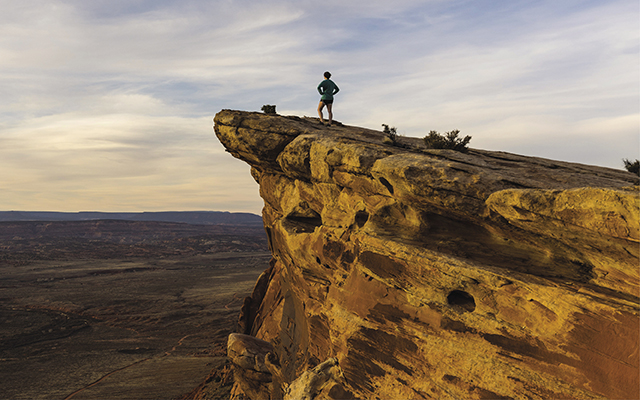Dazzling, incandescent stars glisten in a sky as dark as a raven’s feathers. They appear so close it seems I can pluck one from the heavens and hold it in my hand. But it’s impossible to grasp stardust. That’s its magic.
As I stare into this darkest, yet brightest, nighttime sky I’ve ever seen, I finally comprehend what naturalist Ellen Meloy wrote about this part of southeastern Utah: “The nights are coal-black and water-deep, the light often too bright to understand.”
I love the intensity of deserts. The sun shines brighter. Dryness feels more arid. Landscapes seem vaster. Trees appear greener. Water is more appreciated. Solitude seems quieter.
In Bears Ears National Monument, the desert’s fierceness is magnified. It’s what has made this pristine wilderness beloved by hikers, rock climbers, and stargazers.
Inaccessibility has helped preserve this massive swath of mesas and forest, as well as its scientific and cultural artifacts. But a reinvigorated battle over what to do with the layered richness of this land has made it ground zero in the debate over how to live in a world of rapidly changing climate.
Historic Coalitions
After hours of driving through spartan towns and a pink-and-white swatch of Utah desert, I finally spy two buttes — tall, flat-topped rock towers created by erosion. Once visible, these citadels rise above the land like sentries.
Considered sacred by indigenous peoples, these twin formations are so notable, explained President Barack Obama in his 2016 proclamation establishing the area as a national monument, that they share the same name in each respective native language, meaning “Bears Ears.”
A historic intertribal coalition — consisting of the Navajo Nation, the Hopi Tribe, the Pueblo of Zuni, the Ute Mountain Ute Tribe, and the Ute Indian Tribe — proposed the monument designation to preserve cultural artifacts and ancestral lands for future generations and to ensure that traditional ceremonies and practices could continue here.
“For the first time in history, five sovereign nations came together to advocate for Bears Ears National Monument in order to protect this sacred cultural landscape that carries deep meaning for our people,” says Carleton Bowekaty, Zuni councilman and Bears Ears Intertribal Coalition cochair.
“The establishment of Bears Ears National Monument was a healing moment of historic importance,” says activist Terry Tempest Williams, author of The Hour of Land: A Personal Topography of America’s National Parks. “A unique agreement was reached between Indian tribes and the United States government for a collaborative approach to the management of Bears Ears. It was a clasp of hands across history.
“It was also about America looking into the deep future rather than into the narrow exhaust pipe of today. It was about drilling for hope and dignity rather than fossil fuels.” (Read more from Williams on public-land management.)
Monumental Clashes
Opposition to the creation of Bears Ears National Monument was, and is, strong among those who are concerned that additional regulations will inhibit job growth and prevent cattle ranching — including Utah’s governor and members of its congressional delegation. (The original designation explicitly honored existing grazing rights and leases.)
They now have an ally in the White House. In 2017, in an unprecedented move to abolish a national monument, President Donald Trump slashed the size of Bears Ears by 85 percent, despite overwhelming public support for preserving the borders around its original 1.35 million acres.
This order opened the door for development. But what kind of development can we expect? Southeastern Utah’s Cold War–era uranium-mining boom has gone bust. Oil and gas extraction from the area’s mineral-streaked sandstone alcoves hasn’t typically been seen as economically viable. Several Bureau of Land Management leases were recently purchased, however, near the monument’s original boundaries.
Monument supporters point to the growth of outdoor mecca Moab and other towns just to the north, arguing that tourism and recreation can build a stronger, more sustainable economy in Utah’s poorest county.
Still, the monument’s fate is likely to be determined by the courts. The intertribal coalition, conservation groups, and clothing company Patagonia have all filed lawsuits challenging the current administration’s decision.
Living History
Bears Ears contains more than 100,000 archaeological sites dating from 10,000 years ago.
On my pilgrimage through the sandy washes of Mule Canyon’s South Fork to House on Fire — a well-preserved granary built into vertical cliffs by the Anasazi people — the only sounds were echoes of bird calls off striated rocks.
Shutterbugs make this trek to commune with nature and record history. They wait (sometimes for hours) to capture the perfect shot: the sun’s rays lighting up flamelike patterns in the sandstone.
Farther into the canyon lie a collapsed kiva, petroglyph panels, and fire pits that serve as portals for learning about ancient civilizations.
While these structures have withstood natural forces, they’re often damaged by people who touch the panels (which speeds up erosion), walk into the kiva, stack rocks into cairns, illegally loot artifacts, and desecrate graves.
Conservationists hope that additional federal protections that accompany national-monument status might curb actions like these by providing greater oversight and stiffer penalties. Still, others are concerned that such protections will raise the area’s profile, attracting more people and leaving larger footprints on the land.
From Carbon Sink to Carbon Source
The original monument boundaries included the Manti-La Sal National Forest. This remarkable network of Engelmann spruce, ponderosa pine, aspen, juniper, and hackberry trees provides habitat and food for birds, small mammals, reptiles, and the densest black-bear and largest elk populations in Utah.
It’s also home to a stunning diversity of flora. Vibrant crimson pods of Indian paintbrush, bunches of yellow bee-flower, and delicate petals of sego lilies delighted me as I scaled down canyon walls in Natural Bridges National Monument.
Amid the iconic sagebrush and yucca stand rabbitbrush and barberry. The jubilant spring bloom offered glimpses of monkey flower, bladderpod, sand verbena, and other wildflower varieties I’ve never seen elsewhere.
Undisturbed forests like this continuously absorb carbon dioxide from the atmosphere, counteracting a significant driver of global warming. Trees, shrubs, and soil sequester the greenhouse gas, making forests crucial for sustaining local ecosystems and mitigating climate change.
But deforestation — permanently clearing forests to make land available for development, logging, farming, and other uses — is increasing worldwide. An estimated 18 million acres of forest are lost annually, and half of the world’s tropical rainforests have already been destroyed, mostly during the last three decades. For example, about 17 percent of the Amazon rainforest has been lost in the last 50 years, mostly cleared for cattle ranching.
This affects more than just atmospheric carbon levels. Deforestation is now the leading cause of species extinction. Nearly one-third of threatened and endangered species in the United States rely on forest habitats. Further, an estimated 1.6 billion people depend on forests for food, water, clothing, shelter, and traditional medicine.
Dig In Against Deforestation
Planting a tree in your yard is a simple but important action you can take to combat declining tree cover. (It can also reduce home energy bills and increase a property’s value.)
On a larger scale, the Nature Conservancy is creating carbon-trading markets that allow developing nations to generate income from protecting rather than destroying forests. In Brazil, for example, the organization is establishing two large-scale forest-carbon pilot projects that will cover a combined 47.4 million acres — an area more than twice the size of Portugal.
Preliminary studies indicate that these demonstration programs may reduce carbon-dioxide emissions by approximately 980 million tons — roughly the annual energy use of 80 million U.S. homes.
The National Forest Foundation and U.S. Forest Service have teamed up on projects to jump-start recovery and increase the resiliency of forests affected by wildfires, disease, and damage from infestations of insects, including pine and spruce beetles.
Safeguarding forests by creating “strictly protected areas” — such as national and state parks — appears to be an effective strategy for reducing deforestation. In a 2013 study, University of Michigan researchers examined three categories of land conservation in the Amazon: strictly protected areas, sustainable-use areas, and indigenous lands. Strictly protected areas consistently avoided more deforestation than sustainable-use areas, regardless of the level of deforestation pressure.
Visiting public lands, including national and state parks and forests, is a great way to show your financial support for full conservation of our natural resources.
For me, Bears Ears National Monument served as a natural temple. Its rock art drew me into the past. Its towering cliffs and tiny lizards reminded me of my values and place in the world. Its vastness allowed me to envision what I want for the future — which is the first step toward creating that reality.
This originally appeared as “Respect and Protect” in the January-February 2019 print issue of Experience Life.




This Post Has 0 Comments